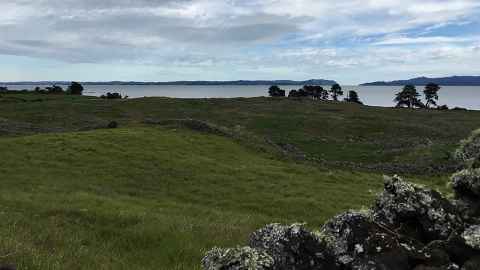Reflections of an archaeology student on Ihumātao
1 August 2019
The situation at Ihumātao stonefields affects the wider community, writes Patricia Pillay.

When I was eight, I took my first steps into Auckland War Memorial Museum and my curiosity was sparked by the cultural objects on display from the ancient world.
Over the years I became more aware of Auckland’s spectacular landscapes. Who were the people who once occupied Maungakiekie pa or the slopes of Maungawhau, Mount Eden, and why was the landscape shaped in the remarkable way that it was?
As a fifth-year postgraduate student studying archaeology, I am disturbed by the fact one of our oldest settlements, Ihumātao Peninsula in Mangere, is threatened by commercial development. Recent protests led by Save Our Unique Landscape (SOUL) at the site have made headlines and feelings are high.
Archaeological evidence shows that Ihumātao was one of the earliest occupied landscapes, containing remnants of some of the first people of Aotearoa. The area includes burial caves, refuse areas or midden and fire remains (charcoal), which act as time capsules providing glimpses into early Māori settlement. Radiocarbon dates from the midden and charcoal go back as early as the 1400s with the early Polynesian settlers.
I have deep respect for our unique landscapes and my generation of archaeologists stands with tangata whenua.
Ihumātao consists of distinct land forms moulded by lava flows. The volcanic landscape has fertile soil with good drainage. It was a productive area for early Māori to cultivate gardens and build a settlement with fortified defences on the volcanic field.
At Ihumātao, around 450 hectares of land was confiscated from iwi under the NZ Settlements Act 1863, and sold to European settlers to be farmed for 150 years. Now, 32 hectares is zoned by Auckland Council to become a Special Housing Area (SHA) where 480 houses will be built.

Archaeological authority has been granted to oversee the development by Heritage NZ, supported by the Environmental Land Court.
But this undeveloped area is wahi tapu (a sacred place) to the Te Wai o Hua o Ihumātao (Māori community). Although Heritage NZ granted authority for the development to “exclude areas of burial caves” and remains of historical features, the area still holds archaeological and cultural value, much of which is yet to be discovered.
The local iwi, Te Kawerau ā Maki, negotiated eight hectares to be returned to their iwi. The Government says it won’t intervene as Te Kawerau ā Maki supports the development. But to wider Māori this landscape represents a living culture and there is high risk of obliterating remaining archaeological and cultural values embedded there. As archaeologist Dave Veart told The Listener, “it’s like building houses alongside Stonehenge”.
While it may be too late to stop this housing development, it’s not too late for all New Zealanders to look after other sites. I have deep respect for our unique landscapes and my generation of archaeologists stands with tangata whenua. Should Māori be forced
to spare one more acre? What will be left for future generations if all traces of the past disappear?
The views in this article reflect personal opinion and are not necessarily those of the University of Auckland.
Patricia Pillay is a 2019 Kupe Leadership Scholar doing a masters in archaeology. Applications close for the 2020 Kupe Leadership Scholars on 23 August.
Find out more about the Kupe Leadership Scholarship.